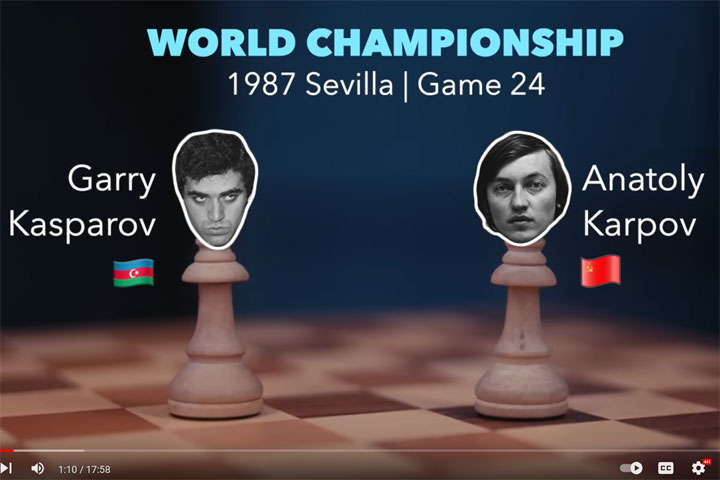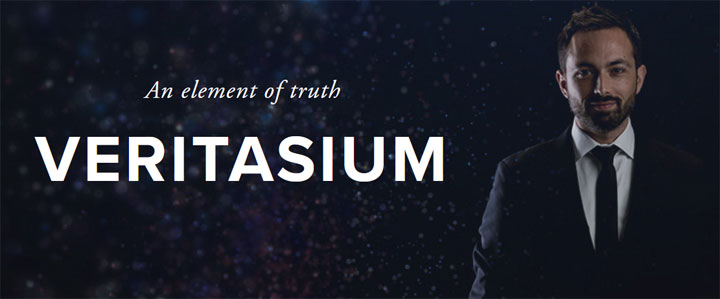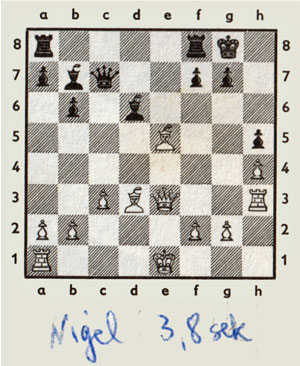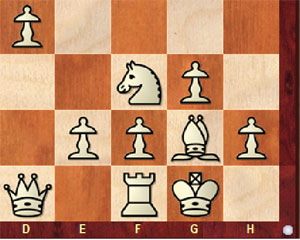



Veritasium is a channel of science and engineering videos featuring experiments, expert interviews, cool demos, and discussions with the public about everything science. Its Youtube channel is hugely successful. It has between 5 and 90 million views per episode.
This week Veritasium did a very interesting episode on what it takes to become an expert in many different areas of life. One of them is chess. And there is a wonderfully lucid description of the processing of chess by the human brain. It is well worth watching:
Especially interesting is the comparison of experts and amateurs. Interesting for me, since I conducted similar research almost forty years ago. That I would like to share with you in this article. I need to start with some background.
In the late 1970s I was a science journalist making documentaries for German television. One day I suggested to my boss that we make a report on how computers could play chess. It was very successful, and the other German channel asked me to do a similar report. This time we decided to concentrate on the difference between human and computer thinking. For that we needed subjects. So I invited a young boy — a very talented young boy — to come to Hamburg and to play in a tournament which was going to be staged there. His parents agreed to send him alone, since I volunteered to put him up in my house and look after him. He had just turned 15, and I arranged for Lufthansa to chaperone him when he had to change planes at the airport in Dusseldorf. When I picked him up in Hamburg I looked around for a little boy, but was greeted by an almost six-foot tall lad.
This was the teenage Nigel Short, with whom I did a lot of filming and a lot of experiments. He became a family friend and returned to visit maybe 20 times. It was always a great deal of fun.
 For the second TV documentary I did a fair bit of research on how the human brain processes the game of chess. I discussed it with the Dutch scientist Adriaan de Groot, who was the world's leading expert in the cognitive analysis of chess masters. In the 1940s to 60s he had conducted tests and described his results in a famous book, Het denken van den schaker. Adrian (right) helped me to design the experiments we would conduct for the documentary in Hamburg.
For the second TV documentary I did a fair bit of research on how the human brain processes the game of chess. I discussed it with the Dutch scientist Adriaan de Groot, who was the world's leading expert in the cognitive analysis of chess masters. In the 1940s to 60s he had conducted tests and described his results in a famous book, Het denken van den schaker. Adrian (right) helped me to design the experiments we would conduct for the documentary in Hamburg.
For the TV documentary I used Nigel as a subject, and while he stayed at our home I conducted a number of experiments with him. He became my prime object of research. My experiments would proceed as follows: I would set up a position on the dining table and then call Nigel, who was typically strumming a guitar in the living room. As he approached I would, stopwatch in hand, watch his eyes. As soon as they hit the chessboard I would start the watch, and the moment he reacted – said anything – I would press “lap.” If it was “You want me to look at this position?” I would wait until he said something position-specific, like “doesn’t bishop takes pawn win?” Then I would stop the watch. I discovered that it took Nigel between five and twenty seconds to solve most tactical problems I set up for him.

I would also use chess books, showing him a position (while covering the solution with my thumb). This picture is from a book I still own, where I noted that Nigel found the key, Qh6, in 3.8 seconds.
I also tested his honesty. I would occasionally set up a position I had shown him a year earlier. He would inevitably say “Hang on, haven’t you shown me this before?”
While conducting these experiments I discovered something quite remarkable. Sometimes the reaction came in less than one second: he would recognize a once-seen position almost instantly. I told some researchers in the psychology department of the University of Hamburg about this, and they explained patiently that what I was describing could not possibly be correct: it was cognitively impossible for a human being to identify a chess position, with over twenty pieces on the board, in less than a second. They started to analyse — me! They told me that it often occurred that researchers exaggerated their findings out of pure enthusiasm for the subject material. It was clear that I had not been timing Nigel accurately. So I invited them to come over to my house and test the lad themselves. This they did, bringing a chess savvy psychologist along, and ran tests on the lines described above. They showed Nigel positions from obscure East German games and asked him to find winning moves. He did that in seconds, and they spent the afternoon wondering if there was some trick involved. According to their understanding of the cognitive functioning of the brain, Nigel could not have done what he just did. A group of bewildered scientists left my house.
 To scientists and the TV audience I tried to explain that Nigel was not scanning 24 (or more) pieces. He was seeing five or six “super-pieces” on the board. These are chunks or configurations that make sense. The ten pieces here do not need to be individually scanned – a single glance will tell the master it is a “fianchettoed bishop in front of a castled king”, and that it came after a 1.d4 opening. The master sees this instantly, and equally quickly draws conclusions: the knight is defending the d-pawn, the bishop is potentially defending the e4 square, as well as attacking b7 and the rook on a8, etc. Very strong chess players have a “vocabulary” of tens of thousands of such chess words, which they recognize and employ with great virtuosity.
To scientists and the TV audience I tried to explain that Nigel was not scanning 24 (or more) pieces. He was seeing five or six “super-pieces” on the board. These are chunks or configurations that make sense. The ten pieces here do not need to be individually scanned – a single glance will tell the master it is a “fianchettoed bishop in front of a castled king”, and that it came after a 1.d4 opening. The master sees this instantly, and equally quickly draws conclusions: the knight is defending the d-pawn, the bishop is potentially defending the e4 square, as well as attacking b7 and the rook on a8, etc. Very strong chess players have a “vocabulary” of tens of thousands of such chess words, which they recognize and employ with great virtuosity.
So what is it like for amateur chess players to be confronted with the same task? We showed absolute beginners the same positions that Nigel had solved in seconds, and in fact used an optical scanning device to track their eye movement. They were indeed looking at all the individual pieces – and seeing nothing. And they could not solve the tactics.
![]()
On the other hand the eyes of World Championship candidate András Adorian moved around the board in general, pausing on piece clusters, but also on empty areas. In one experiment (picture above) he said: "This is very easy!" and proceeded to execute the combination, in which he used the a1 rook which he had never directly looked at!
In addition we gave András random positions with no chess meaning (e.g. with pawns on the first rank, the white king somewhere in the middle of enemy pieces) to look at for five seconds. Then we asked him to reconstruct the position on a separate board. The result: he got just five or six pieces right, almost exactly the same number as rank amateurs were able to remember from meaningful chess positions.
To make all this clearer to my audience, I conducted the following experiment: I told them to watch the screen, where I would flash 26 letters of the alphabet for five seconds. After that they were to write down as many of the letters as they could remember. Then the following appeared on the screen:
The postman came and delivered
Of course, the audience did not need five seconds to memorize all 26 letters and their positions. They could do it immediately, and flawlessly. The reason was that they were not memorizing individual letters, but words. I then asked them to “complete the sentence.” They immediately came up with meaningful suggestions: “... a letter”, “... a parcel,” etc. And I praised them for being “grandmasters” of language. What they did was similar to what Nigel was doing on the chessboard.
To give the audience an impression of what chess felt like to an amateur, I flashed the following string of letters on the screen for five seconds.
Postimies tuli ja toimitti
This time they could only memorize a few letters, like “Post” and “tuli,” and they certainly couldn’t complete the sentence – which was in Finnish. They were in the position of a chess amateur, who could only remember five or ten pieces, and didn’t have a chance of finding the winning move.
My experiments with Nigel remain instructive and illuminating for me to this day. If I still have your attention, you might want like to hear me talk about the encounters and the experiments described above. It starts by telling you how I got involved in this kind of research, and how we presented the results to the German TV audience.